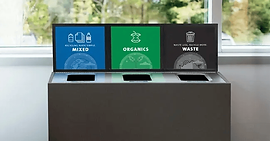Canada
- Written by Kelsey

Which kind of waste bins do you have in your household?
In my house we have a few different types of waste bins. These include black/grey bins for traditional landfill waste, green bins for organic material such as plants and other natural materials, compost bins for kitchen scraps, and blue bins for multiple types of recycling. Recyclable materials fall into categories such as paper materials, various types of plastic containers, paper cups, tetra-pack and cartons,

Canadian recycling bin (Image: Recycle Away)
aluminum containers like soda cans, steel containers like canned goods, glass bottles and jars, flexible plastic packaging, and foam packaging. Recyclable items are collected via different systems depending on the municipality. Depending on your local recycling infrastructure, items are either collected all together with these different categories ‘co-mingled’ into one collection bin and later sorted at the recycling facility, also known as single-stream recycling. Other municipalities require recycled items to be sorted into respective categories before they are collected. Many places in Canada offer curb side pickup for recycling alongside garbage collection on certain days of the week to encourage recycling efforts.
What kind of textile waste recycling points are there?
Textile recovery and recycling efforts are unfortunately not very developed in Canada and although interest is gaining and many efforts are now being undertaken, they are still in their infancy. Due to the recent nature of these textile waste management initiatives,

Donation bins at Value Village, New Westminster, BC (Image: Value Village / Savers)
awareness of the actual scope of the issue is not well known to the public and not widespread knowledge of these larger scale recovery programs. However, there are many collection points for used clothing and home goods as many organizations and secondhand stores exist in Canada and are well known places for donating used goods as well as shopping for new items. These types of donation points are often second hand shops, but there are also charity donation points for used goods to support those in need. There are maps of donation points available online but no single overarching comprehensive map. Many maps found online only show collection points specifically for their individual organizations, but searching on an internet browser for clothing donations in a specific city will yield a Google map with a collection of various donation points around the city.
What is the general attitude toward secondhand clothing in Canada?
There is a positive general attitude toward secondhand clothing and items in Canada. Thrifting clothes is seen as quite trendy especially among younger generations, and can be viewed as a fun, enjoyable activity to do with friends. In a modern world of fashion where mass production, pervasive micro trends, and cheap style duplicates dominate the market, thrifting can be seen as a great way to find unique styles and quality pieces not to mention also being economically and environmentally friendly. I would say many people also tend to make an effort to reduce direct consumer waste by giving clothes to family and friends, reselling clothes, and donating to second-hand shops when they no longer have use for articles of clothing.

Salvation Army Thrift Store (Image: Magasin d’Occasion).
Where do people usually buy or sell secondhand clothes?

Ontario Flea Market (Image: McHaffie Flea Market)
There are many second-hand stores, thrift stores, curated vintage shops, and resale economies utilizing online markets to reach consumers. Shopping in person at thrift stores is a main method of obtaining second hand clothes. Another method that is becoming more and more popular is using online platforms to sell items to hopefully reach a large amount of people. There are more locally based markets for this such as Facebook Marketplace which searches the local area, or other sites like Vinted, Poshmark, and Depop which reach a broader range of consumers.
How much textile waste is generated in Canada? How much ends up in landfills, how much is recycled ?
A study from 2023 from the University of Waterloo and Seneca College states that Canadians toss away close to 500 million kilograms of fabric items on a yearly basis. This is on average 37 kg of textiles discarded per person every year. In 2021 specifically, Canadians were reported to have disposed of 1.1 million kilograms of textile waste.
Synthetic textiles in Canada account for 7 per cent of all plastics in Canadian landfills, and make up the third-largest category of plastic waste in absolute numbers after packaging and automotive (Deloitte, 2019). Fashion Takes Action estimated the absolute volume of synthetic and blended textiles in Canada’s landfills in 2018 was 360 kilotons. It is likely these numbers are signficantly higher now due to the increasing trends of fast fashion, online shopping, and clothing made of synthetic material for an intended purpose such as athletic wear or outdoor wear.
Some donated clothing is recirculated, but much of the textile waste that could be recycled ends up in the landfill. There is almost no textile recycling currently in Canada.
How many pieces of clothing does the average person in Canada own?
There was not much information available online about how many pieces of clothing each Canadian owns on average. It seems many statistics are based on spending amounts rather than empirical data on the number of clothing items owned. Statistics Canada data found that the average Canadian household spent around $2,303 on clothing and accessories in 2021. If I were to give an estimate however, I would say 100+ clothing items especially with younger generations being more prolific fashion consumers.
What is one thing that your country could learn from Malaysia/ U4B?
U4B has much more developed textile recovery and recycling than Canada. Although the issue of textile waste is now starting to be more widespread knowledge and more efforts are beginning to be introduced, there is not much actual development yet of textile recycling infrastructure. While studies, roadmaps, and assessments of the feasibility of developing this infrastructure in Canada have been conducted, there has not been any significant forward progress into the implementation of mechanical or chemical recycling. Some donated clothing items are successfully recirculated, but still many clothes end up in the landfill or being shipped to other countries where they may end up as textile waste. Canada could definitely learn much from U4B about how important it is that this problem be addressed and the sooner it is, the more reach and impact they will be able to have.
What are some national campaigns or organizations in your country promoting textile recycling or reuse?
Fashion Takes Action (FTA) is a non-profit fashion industry organization focused on sustainability. FTA works with industry and consumers to shift behaviour toward more positive social and environmental impacts in the entire fashion system through education, awareness, research, and collaboration.
FTA, with support of the Government of Canada also has created the Canadian Circular Textiles Consortium (CCTC), which is a platform to establish and connect stakeholders for circular textile projects to reduce duplication of efforts and enhance collaboration between agencies and organizations. The CCTC has established working groups and sub committees to undertake various projects related to policy and education, as well as research and pilot programs.
Canadian Plastics Innovation Challenges is a government initiative to support innovative solutions to address the problems of plastics waste and pollution. Winning proposals received up to $150,000 to develop proofs of concept for inventions such as Singular Solutions Inc. who worked on developing a bio sustainable additive that facilitates the biodegradation of plastic textile waste in long-term composting facilities, and Met-Tech Inc. who worked on developing a low-cost process for chemical recycling, sorting, separation, and the removal of dyes from waste textiles.
Which facts shocked you during your research?
I was surprised to find out that even though Canadians feel the recycling system is quite good, especially compared to our neighbours like the United States, there is little recycling of textile and apparel waste compared to traditional recycleables. Most waste is landfilled, incinerated, turned into rage, or baled and exported (likely to developing countries).
I was also very shocked to find out during my research that synthetic microfibres released from domestic laundries are the predominant source of microplastic pollution in the ocean at 35%.
References
Government of Canada. (2024, July 8). Addressing plastic waste and pollution from the textile and apparel sector: consultation document. Www.canada.ca. https://www.canada.ca/en/environment-climate-change/services/managing-reducing-waste/consultations/roadmap-plastic-waste-pollution-textile-apparel-sector/proposed-roadmap-plastic-waste-pollution-textile-apparel-sector.html
Weber, S., Weber, O., Habib, K., & Dias, G. M. (2023). Textile waste in Ontario, Canada: Opportunities for reuse and recycling. Resources, Conservation and Recycling, 190, 106835. https://doi.org/10.1016/j.resconrec.2022.106835
Braich, B. (2022, February 28). Textile waste is a growing problem — and Canada still isn’t doing enough to solve it, experts say. CBC. https://www.cbc.ca/news/canada/british-columbia/textile-waste-recycling-bc-canada-1.6357584
Weber, S. (n.d.). A Feasibility Study of Textile Recycling in Canada (p. 170) [Review of A Feasibility Study of Textile Recycling in Canada]. https://static1.squarespace.com/static/6759d7c670eb2945639cdfda/t/67dc4b5abd79e96d29f4ee09/1742490463430/FTA-A-Feasibility-Study-of-Textile-Recycling-in-Canada-EN-June-17-2021.pdf
How to Sort - Recycle BC. (2015, September 25). Recycle BC. https://recyclebc.ca/how-to-sort/
Nielsen, K. (2023, January 23). Canadians Dump 500M Kilograms of Textiles a year. Ontario Researchers Hope to Change That | Globalnews.ca. Global News. https://globalnews.ca/news/9430446/textile-waste-fast-fashion-ontario-research-recylcle/
Hopper, T. (2019, January 8). Why are so many people dying in Canadian clothing donation bins? Nationalpost; National Post. https://nationalpost.com/news/canada/why-are-so-many-people-dying-in-canadian-clothing-donation-bins
Government of Canada, S. C. (2023, December 15). Getting ready to go out. Www.statcan.gc.ca. https://www.statcan.gc.ca/o1/en/plus/5228-getting-ready-go-out

